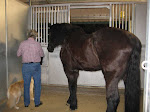Yesterday, I got a load of hay and felt like I got a really good deal on it. Then I went to a special board I like to hang out on and keep track of other horse people. This morning they started a discussion about the cost of hay in various parts of the country. Some were paying prices that made me whimper with envy and others were paying prices that had me glad I'm where I am.
I shared the following with the board that I learned many years ago. Prices are all over the place when it comes to feeding horses and around here droughts usually keep the price of hay pretty high so I learned how to manage my costs and yet keep my horses in good condition.
I bought a scale and tape and started weighing my horses and their feed.
Once I started doing that my feed costs dropped dramatically and yet my horses stayed in good flesh.
I began by feeding two pounds of hay and half-a-pound of hard feed (I like pellets) per hundred pound of horse. This is 20 pound of hay and 5 pounds of pellets for a thousand pound horse. I divide it into two feedings. I turn out during the day (no night turn outs because we have a problem with dogs in this area). My pasture ranges from great to awful depending on season and rain.
I then measure my horses daily and if anyone is gaining or losing too fast I adjust the amounts. My Welsh ponies get one pound of hay per hundred pounds and a handfull of pellets. My DD's Arabian mare gets a pound and a half of hay and a pound of grain per hundred pounds. My gaited horses get two pounds of hay per hundred and a pound of pellets (just one pound period). All are healthy and in good flesh.
I taped them daily and adjusted amounts if I upped their exercise or noticed anyone gaining or losing weight.
Lazy Trainer Tip
The best way to control feed cost is to buy a good scale and tape then use them until you know what each horse really needs to maintain good health and energy levels.
Oh yes, don't forget regular worming and good dental care too.
Subscribe to:
Post Comments (Atom)










No comments:
Post a Comment